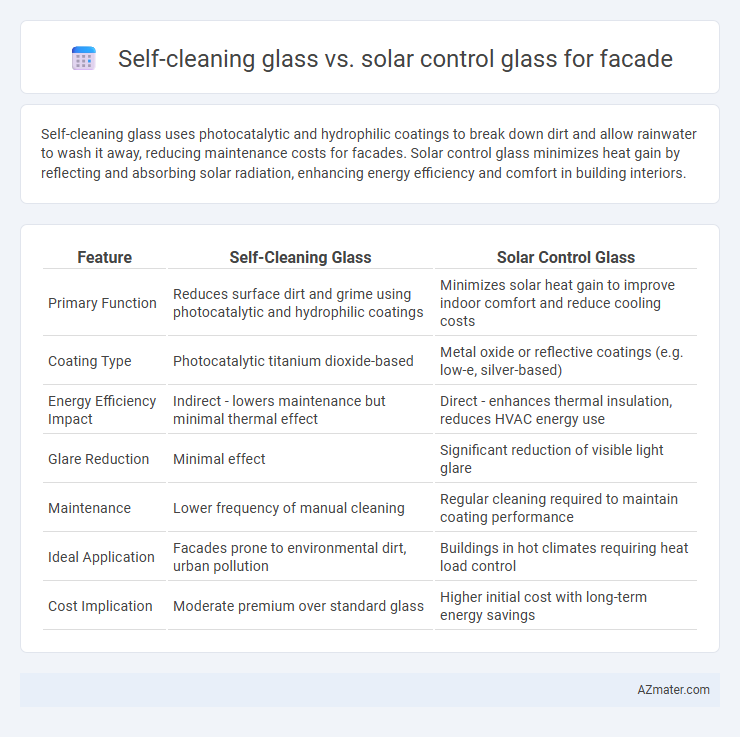Self-cleaning glass uses photocatalytic and hydrophilic coatings to break down dirt and allow rainwater to wash it away, reducing maintenance costs for facades. Solar control glass minimizes heat gain by reflecting and absorbing solar radiation, enhancing energy efficiency and comfort in building interiors.
Table of Comparison
| Feature | Self-Cleaning Glass | Solar Control Glass |
|---|---|---|
| Primary Function | Reduces surface dirt and grime using photocatalytic and hydrophilic coatings | Minimizes solar heat gain to improve indoor comfort and reduce cooling costs |
| Coating Type | Photocatalytic titanium dioxide-based | Metal oxide or reflective coatings (e.g. low-e, silver-based) |
| Energy Efficiency Impact | Indirect - lowers maintenance but minimal thermal effect | Direct - enhances thermal insulation, reduces HVAC energy use |
| Glare Reduction | Minimal effect | Significant reduction of visible light glare |
| Maintenance | Lower frequency of manual cleaning | Regular cleaning required to maintain coating performance |
| Ideal Application | Facades prone to environmental dirt, urban pollution | Buildings in hot climates requiring heat load control |
| Cost Implication | Moderate premium over standard glass | Higher initial cost with long-term energy savings |
Introduction to Advanced Façade Glass Technologies
Self-cleaning glass incorporates photocatalytic and hydrophilic coatings that break down organic dirt and allow rainwater to wash away residues, reducing maintenance efforts. Solar control glass filters out infrared and ultraviolet rays, improving energy efficiency by minimizing heat gain while maintaining natural daylight transmission. These advanced facade glass technologies enhance building performance by combining aesthetics, sustainability, and operational cost savings.
What is Self-Cleaning Glass?
Self-cleaning glass features a special coating that uses photocatalytic and hydrophilic properties to break down organic dirt and allow rainwater to wash it away, significantly reducing maintenance efforts. This glass type enhances facade cleanliness and transparency, making it ideal for high-rise buildings where manual cleaning is challenging. Unlike solar control glass that primarily focuses on reducing heat gain and improving energy efficiency, self-cleaning glass provides a low-maintenance solution without compromising natural light.
Understanding Solar Control Glass
Solar control glass is designed to reduce solar heat gain while maintaining high visible light transmission, improving energy efficiency in building facades. It incorporates coatings that reflect infrared radiation, minimizing cooling loads and enhancing occupant comfort. Unlike self-cleaning glass, solar control glass primarily targets thermal performance rather than surface maintenance.
Core Functionalities: Self-Cleaning vs Solar Control Glass
Self-cleaning glass incorporates a photocatalytic coating that breaks down organic dirt with sunlight, reducing maintenance and preserving clarity. Solar control glass utilizes a specialized coating or film to reflect infrared radiation, minimizing heat gain and improving energy efficiency in buildings. Both glass types enhance facade performance, with self-cleaning glass optimizing cleanliness and solar control glass optimizing thermal regulation.
Benefits of Self-Cleaning Glass in Building Façades
Self-cleaning glass significantly reduces maintenance costs and labor by utilizing a hydrophilic coating that breaks down organic dirt and washes away debris with rainwater, ensuring long-lasting clarity and aesthetics. This technology improves natural daylight penetration and energy efficiency by maintaining clearer surfaces compared to solar control glass, which primarily focuses on heat reduction. Its environmental benefits include reducing the need for harsh chemical cleaners and frequent manual cleaning, making it an ideal choice for sustainable building facades.
Advantages of Solar Control Glass for Façade Applications
Solar control glass enhances facade performance by significantly reducing solar heat gain, leading to improved energy efficiency and lower cooling costs in buildings. It minimizes glare while maintaining natural light transmission, providing comfort and visual clarity for occupants. The glass's ability to block harmful UV rays also extends the lifespan of interior furnishings by preventing fading and degradation.
Performance Comparison: Cleaning, Energy Efficiency, and Comfort
Self-cleaning glass reduces maintenance costs by using photocatalytic and hydrophilic coatings that break down organic dirt and wash it away with rainwater, while solar control glass primarily blocks infrared radiation to lower cooling loads. In terms of energy efficiency, solar control glass outperforms self-cleaning glass by minimizing solar heat gain and thereby reducing HVAC energy consumption, whereas self-cleaning glass offers limited impact on thermal performance. For occupant comfort, solar control glass enhances indoor thermal stability and glare reduction, which directly improves comfort levels, contrasted with self-cleaning glass that mainly contributes to facade aesthetics and cleanliness without affecting thermal comfort.
Maintenance and Longevity Considerations
Self-cleaning glass features a photocatalytic coating that breaks down organic dirt and a hydrophilic surface that allows rainwater to wash away debris, significantly reducing cleaning frequency and lowering maintenance costs. Solar control glass incorporates coatings that reflect infrared radiation, minimizing heat gain while maintaining visible light transmission; this technology does not impact cleaning requirements but can extend facade durability by reducing thermal stress. Both types enhance facade longevity by decreasing deterioration factors, with self-cleaning glass prioritizing cleanliness maintenance and solar control glass focusing on thermal regulation for structural preservation.
Cost Implications and Return on Investment
Self-cleaning glass reduces maintenance costs by minimizing the need for manual cleaning, making it ideal for high-rise facades where cleaning access is expensive; however, its initial price is typically higher than standard glass. Solar control glass enhances energy efficiency by blocking heat and reducing cooling loads, potentially leading to significant long-term savings in HVAC expenses, offsetting its higher upfront cost through improved energy performance. Choosing between the two depends on balancing immediate cleaning cost reductions with long-term energy savings, where combining both technologies can maximize return on investment in facade applications.
Choosing the Right Glass: Selecting for Your Façade Needs
Self-cleaning glass features a hydrophilic coating that breaks down organic dirt and allows rainwater to wash residues away, ideal for reducing maintenance on tall facades. Solar control glass minimizes solar heat gain through low-emissivity coatings and tinted layers, enhancing energy efficiency and occupant comfort. Choosing the right glass involves balancing maintenance reduction with thermal performance based on facade exposure, climate, and building usage.

Infographic: Self-cleaning glass vs Solar control glass for Façade
 azmater.com
azmater.com